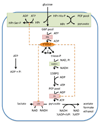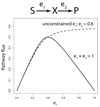Systems biology of lactic acid bacteria: a critical review
- PMID: 21995498
- PMCID: PMC3231918
- DOI: 10.1186/1475-2859-10-S1-S11
Systems biology of lactic acid bacteria: a critical review
Abstract
Understanding the properties of a system as emerging from the interaction of well described parts is the most important goal of Systems Biology. Although in the practice of Lactic Acid Bacteria (LAB) physiology we most often think of the parts as the proteins and metabolites, a wider interpretation of what a part is can be useful. For example, different strains or species can be the parts of a community, or we could study only the chemical reactions as the parts of metabolism (and forgetting about the enzymes that catalyze them), as is done in flux balance analysis. As long as we have some understanding of the properties of these parts, we can investigate whether their interaction leads to novel or unanticipated behaviour of the system that they constitute. There has been a tendency in the Systems Biology community to think that the collection and integration of data should continue ad infinitum, or that we will otherwise not be able to understand the systems that we study in their details. However, it may sometimes be useful to take a step back and consider whether the knowledge that we already have may not explain the system behaviour that we find so intriguing. Reasoning about systems can be difficult, and may require the application of mathematical techniques. The reward is sometimes the realization of unexpected conclusions, or in the worst case, that we still do not know enough details of the parts, or of the interactions between them. We will discuss a number of cases, with a focus on LAB-related work, where a typical systems approach has brought new knowledge or perspective, often counterintuitive, and clashing with conclusions from simpler approaches. Also novel types of testable hypotheses may be generated by the systems approach, which we will illustrate. Finally we will give an outlook on the fields of research where the systems approach may point the way for the near future.
Figures



Similar articles
-
Systems solutions by lactic acid bacteria: from paradigms to practice.Microb Cell Fact. 2011 Aug 30;10 Suppl 1(Suppl 1):S2. doi: 10.1186/1475-2859-10-S1-S2. Epub 2011 Aug 30. Microb Cell Fact. 2011. PMID: 21995776 Free PMC article. Review.
-
Engineering Tools for the Development of Recombinant Lactic Acid Bacteria.Biotechnol J. 2020 Jun;15(6):e1900344. doi: 10.1002/biot.201900344. Epub 2020 Feb 24. Biotechnol J. 2020. PMID: 31995278 Review.
-
Mechanisms and improvement of acid resistance in lactic acid bacteria.Arch Microbiol. 2018 Mar;200(2):195-201. doi: 10.1007/s00203-017-1446-2. Epub 2017 Oct 26. Arch Microbiol. 2018. PMID: 29075866 Review.
-
Genotypic characterization and safety assessment of lactic acid bacteria from indigenous African fermented food products.BMC Microbiol. 2012 May 17;12:75. doi: 10.1186/1471-2180-12-75. BMC Microbiol. 2012. PMID: 22594449 Free PMC article.
-
Dynamics of a microbial community during ensiling and upon aerobic exposure in lactic acid bacteria inoculation-treated and untreated barley silages.Bioresour Technol. 2019 Feb;273:212-219. doi: 10.1016/j.biortech.2018.10.041. Epub 2018 Oct 22. Bioresour Technol. 2019. PMID: 30447622
Cited by
-
Genome duplication and mutations in ACE2 cause multicellular, fast-sedimenting phenotypes in evolved Saccharomyces cerevisiae.Proc Natl Acad Sci U S A. 2013 Nov 5;110(45):E4223-31. doi: 10.1073/pnas.1305949110. Epub 2013 Oct 21. Proc Natl Acad Sci U S A. 2013. PMID: 24145419 Free PMC article.
-
Efficient production of l-lactic acid by an engineered Thermoanaerobacterium aotearoense with broad substrate specificity.Biotechnol Biofuels. 2013 Aug 28;6(1):124. doi: 10.1186/1754-6834-6-124. Biotechnol Biofuels. 2013. PMID: 23985133 Free PMC article.
-
Monte-Carlo modeling of the central carbon metabolism of Lactococcus lactis: insights into metabolic regulation.PLoS One. 2014 Sep 30;9(9):e106453. doi: 10.1371/journal.pone.0106453. eCollection 2014. PLoS One. 2014. PMID: 25268481 Free PMC article.
-
The Effect of Recombinant Protein Production in Lactococcus lactis Transcriptome and Proteome.Microorganisms. 2022 Jan 25;10(2):267. doi: 10.3390/microorganisms10020267. Microorganisms. 2022. PMID: 35208722 Free PMC article. Review.
-
Systems Biology - A Guide for Understanding and Developing Improved Strains of Lactic Acid Bacteria.Front Microbiol. 2019 Apr 30;10:876. doi: 10.3389/fmicb.2019.00876. eCollection 2019. Front Microbiol. 2019. PMID: 31114552 Free PMC article. Review.
References
Publication types
MeSH terms
Substances
LinkOut - more resources
Full Text Sources
Research Materials
Miscellaneous

